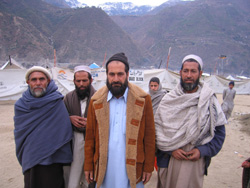You are here » Home » Telling Our Story
First Person
Attendance of children in tent schools increases as more schools open
Village Elder Promotes Education

| |
Photo: USAID
|
|
Members of the Community Elder Board, which promotes education for all children at Maira Camp.
“We want our children to go to school, but there simply aren’t any schools,” said Safraz, the Community Elder Board spokesperson at Mehra Tent Camp in Pakistan’s North-West Frontier Province.
|
People from the Allai Valley in northern Pakistan live in isolated family compounds perched along ridges of the Karakoram Mountains. With no schools nearby, most children had no access to formal education. When the October 2005 earthquake caused homes and barns to collapse, villagers sought shelter in the Mehra Camp, a two- to five-hour walk from their homes. Although adult illiteracy in this area is estimated at 90 percent, parents want their children to go to school. One obstacle to achieving this goal, both before and after the earthquake, is the very limited access to schools and teachers. Safraz, the spokesperson of the Community Elder Board at Maira Camp, told USAID that “We want our children to go to school, but there simply aren’t any schools.”
USAID responded with the help of community leaders, including Safraz, who facilitated community decision-making. Both male and female parent groups debated the merits of classrooms separated by gender. One man argued that the rules of separation do not apply to young children. He said, “Although men and women are traditionally separated, these are just children, and we can allow them to have mixed education.” An education advisor at the camp pointed out, “It is more difficult to find female teachers. From a school management perspective, if boys and girls are in the same classroom, schools can accommodate more children.”
With USAID assistance, the community was able to open two schools in Mehra Camp accommodating 2,100 children. Boys and girls attend elementary school together, while middle school children are separated by gender. When the schools opened, demand for education was so great that USAID helped launch a third school serving an additional 600 children.
Today, USAID is supporting schools in the temporary camps. In the future, it intends to direct funds to training teachers and building permanent schools so that these children’s education continues when they finally return home.
Print-friendly version of this page (529kb - PDF)
Click here for high-res photo
Back to Top ^ | 

